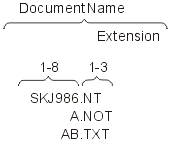Folder and document names should describe the contents of the folder or document.
Folder names must be unique and should be easy to type, as well as descriptive to a user. To find a particular folder on the system and change a document stored in it, you must either supply the folder name or select it from a list of names.
Document names must be unique in the folder and should be easy to type, as well as descriptive. You should give careful consideration to the names you use to help you find the document later.
The name you use for a folder or a document must follow these rules:
- The name must be unique within a folder.
- A document or folder name can be 1 to 12 characters long, including an
optional extension. If no extension is included, a document or folder name
can have a maximum of eight characters. If an extension is included, the extension
must start with a period and can have up to three additional characters. An
extension in the document name allows you to identify the document by using
specific information that can help you do a selective listing of documents
on your system.

- A document or folder name can include any single-byte EBCDIC character
except for the following special characters that the system uses for
other purposes:
Character Special uses Asterisk (*) Multiplication operator, indicates generic names, and indicates i5/OS™ reserved values Slash (/) Division operator, delimiter within system values, and separates parts of qualified object names Question Mark (?) Initiates requests for system help - When a folder is stored in another folder, both folder names are used,
separated by a slash (/). That combination of names is called a folder
path. For example, if a folder named FOLDR2 is stored in FOLDR1, the path
for FOLDR2 is FOLDR1/FOLDR2. FOLDR1 is the first-level folder. FOLDR2
is the next-level folder. The name of a single folder can be 1 to
12 characters long, including an optional extension. A folder path can contain
a maximum of 63 characters.
Folder names should not begin with Q because the system-supplied folder names begin with Q. The following are examples of permitted folder names and folder paths:
@LETTERS FOLDER.PAY PAYROLL/FOLDER.PAY #TAX1/FOLD8.TAX/$1988/PAYROLL/FOLDER.PAY
- In CL commands, folder path names must be enclosed in apostrophes to prevent the system from processing them as qualified (library/object) names. If an apostrophe is to be part of the name, it must be specified as two consecutive apostrophes.
- A number of CL commands act on either documents or folders, and some act on both. The abbreviation DLO (document library object) is used when referring to either a document or folder.
- In CL commands, folder and document names must be enclosed in apostrophes if they contain characters that are CL delimiters.
- The system does not recognize graphic characters; it recognizes only code
points and uses the following assumptions:
- All folder and document names are encoded using single-byte EBCDIC code pages. Since code points hex 41 through FE represent graphic characters in those code pages, they are the only code points that can be used in folder and document names.
- Code points hex 5C, 61, and 6F represent the asterisk (*), slash (/), and question mark (?) respectively, and cannot be used in folder and document names.
- The code points for lowercase letters in English (hex 81 through 89, 91 through 99, and A2 through A9) are converted to the code points for uppercase letters (C1 through C9, D1 through D9, and E2 through E9, respectively).
In addition to the folder and document names previously described, folders and documents are internally classified in the system by their system object names. These are 10-character names derived from date/time stamps, and, while they are generally not known to the user, they may be specified on some CL commands by specifying *SYSOBJNAM for the folder or document name and by specifying the system object name in a separate parameter.